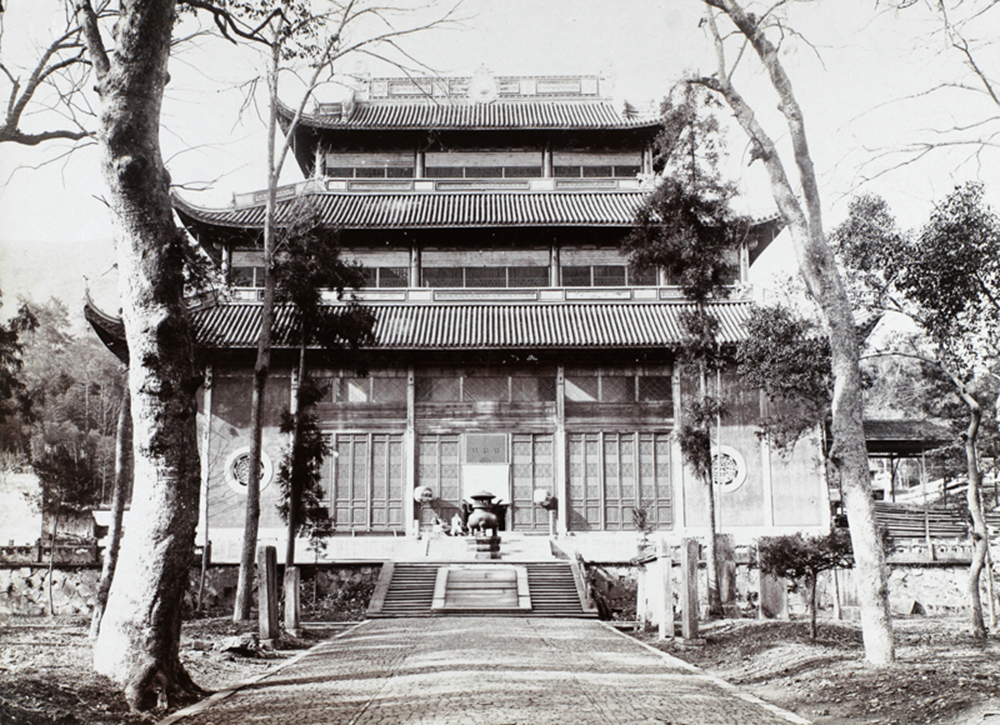Dr Gregory Adam Scott is currently a Leverhulme Early Career Fellow at the University of Edinburgh, and from September 2017 will take up the post of Lecturer in Chinese Cultural History at the University of Manchester.
For the most part, Western visitors to China in the nineteenth and early twentieth centuries regarded Chinese temples, monasteries, shrines, and other religious spaces with a mix of fascination and horror. [i]
Fascination stemmed from the fact that these spaces were often ornately decorated and situated in majestic landscapes, the power of which was palpable and unmediated by barriers or language or culture. Horror was produced because the depiction of deities in a concrete form, especially when the observer was largely ignorant of their identity and symbolism, was extremely alien to the religious sensibilities of many foreign visitors. In spite of this, the photographic and textual archive that they helped create is filled with depictions of Chinese religion. Until quite recently, these types of sites were only rarely photographed, and thus any photograph of a Chinese sacred site from this period is of great value to historians interested in the layout, construction, and artistry of these spaces. Mission archives have proved to be especially rich in this regard, likely because missionaries were professionally interested in religion, and thus paid particular attention to Chinese Buddhism, Daoism, popular religions, and so on.
The Historical Photographs of China collections include images of temple grounds, religious structures, religious images, and religious professionals. The religious spaces depicted therein range from temples for Imperial sacrifice to Buddhist monasteries, from ancestral shrines to a temple converted into a church, and reflect the great range of religious diversity in China, as true today as it was in the period of the photographic record. [ii]
Of the numerous images in the collections that depict Chinese religious spaces, a few in particular stand out:
The Hall of the Four Heavenly Kings at Tien-dong (Heavenly Child Temple), near Ningpo
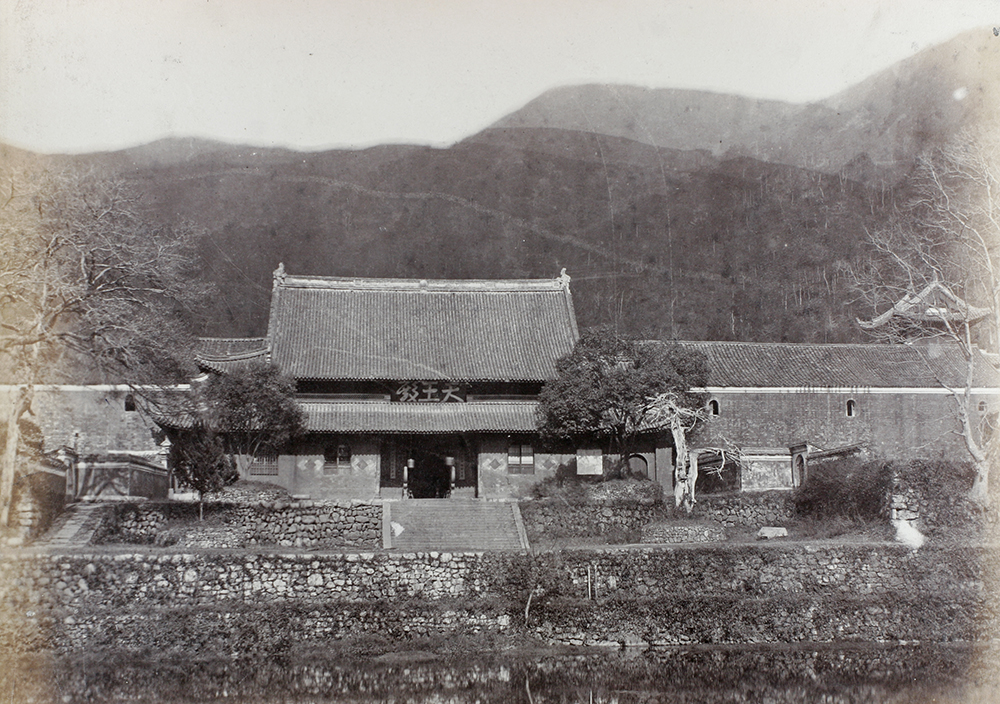
The Hall of the Four Heavenly Kings at Tien-dong (Heavenly Child Temple), near Ningpo, Edward Bowra collection, Bo01-012, © 2008 Royal Society for Asian Affairs
The founding of Tiantong Monastery 天童寺 near Ningbo 寧波 dates back to as early as the fourth century CE, but it was completely destroyed as a result of fighting during the Taiping Civil War (1850 – 1864). This photograph depicts the hall of the Four Heavenly Kings (sida tianwang 四大天王), a building normally located just inside the main gate of a Chinese Buddhist monastery, in front of the main Dharma hall. If the date range of this image is accurate (ca. 1870), it depicts the first generation of reconstruction following the Taiping war. Since the temple was again destroyed by fire and reconstructed in the early 1930s, it provides a glimpse of the monastery’s history not visible today.
Qiniandian, Temple of Heaven, Peking
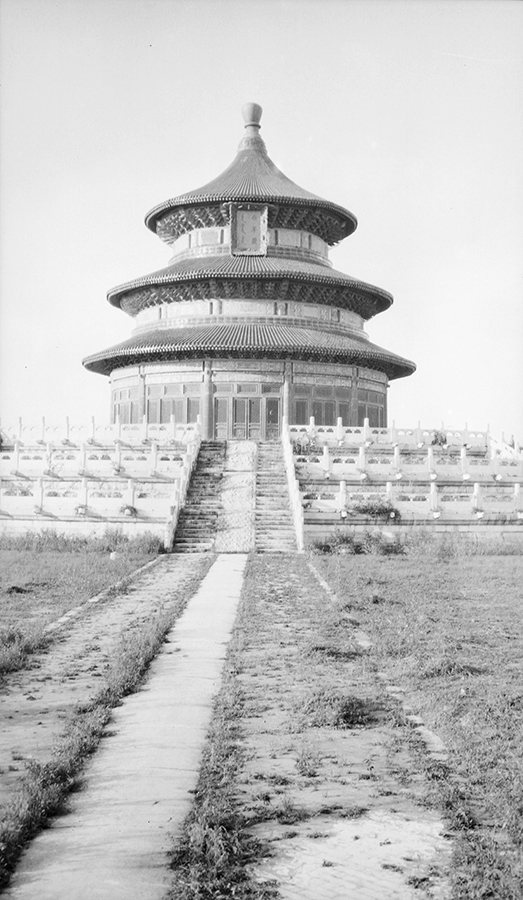
Qiniandian, Temple of Heaven, Peking. Photograph by G. Warren Swire. G. Warren Swire Collection, Sw16-013, © 2007 John Swire & Sons Ltd
Qiniandian, Temple of Heaven, Peking
The Hall of Prayer for Good Harvest (Qinian dian 祈年殿) is one of the most striking, and likely one of the most photographed, structures in the Temple of Heaven in Beijing. At the time of this photograph (1911-1912) the ceremonies normally conducted there by the Emperor would have been suspended due to the Republican Revolution, and the site was briefly open to the public until the short-lived attempt by Yuan Shikai to assume the imperial role. The overgrown grounds are testiment to its having been briefly abandoned as a ritual site.
Lingyin Temple, Hangchow
Like Tiantong Temple, Lingyin Monastery 靈隱寺 in Hangzhou 杭州 was destroyed during the Taiping Civil War. It was not rebuilt until the final decades of the Qing, and the main hall, pictured here, would have just recently been completed when this photograph was taken in 1911. The timbers used to rebuild the temple were imported from America and had originally been intended for use in repairing the Summer Palace near Beijing. These buildings were later damaged during the Second Sino-Japanese War (1937-1945), and further reconstruction work occurred in the 1950s under the new People’s Republic of China.
Large bell on the site of a temple
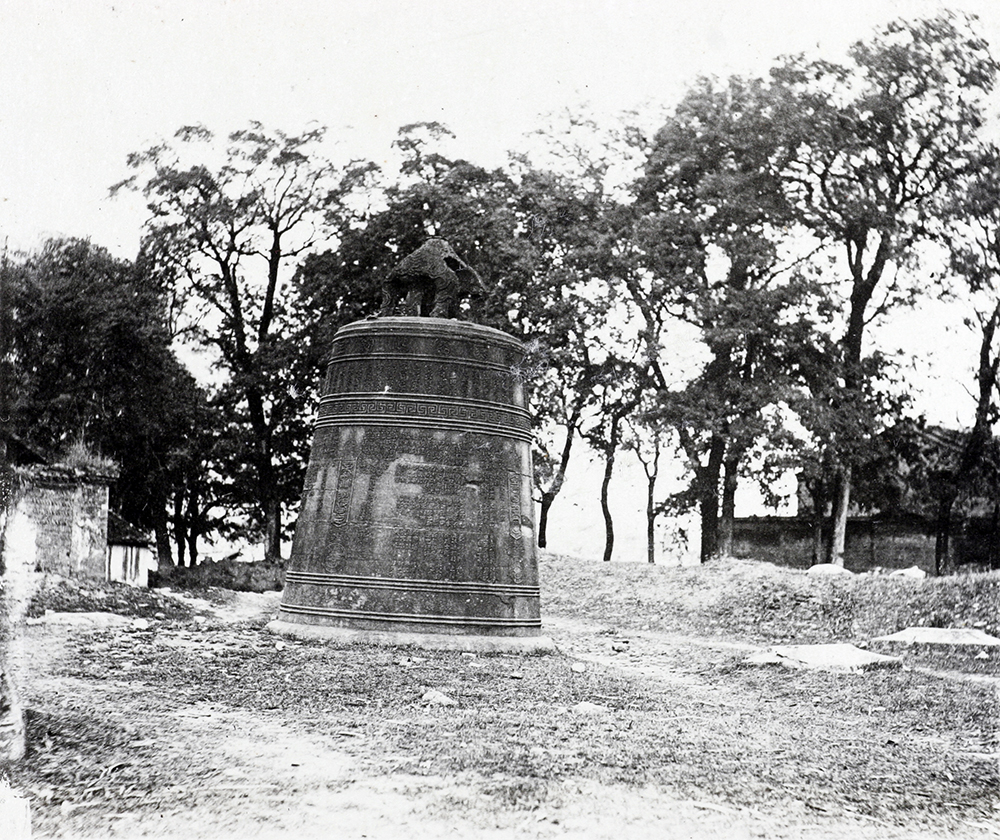
Large bell on the site of a temple. Banister family Collection, Ba04-38, © 2008 Peter Lockhart Smith
While the location of this photograph is not identified, I find it striking as a depiction of the aftermath of the destruction of a sacred site. Thousands of such sites were threatened with destruction in the late Qing and early Republican eras, as a result of warfare, natural disaster, or even anti-religious campaigns. The wood and tiles of this particular religious institution have long since disappeared, leaving only this freestanding bronze bell as evidence that a sacred site used to stand here.
Monks at Silver Island Temple, Ching-Kiang
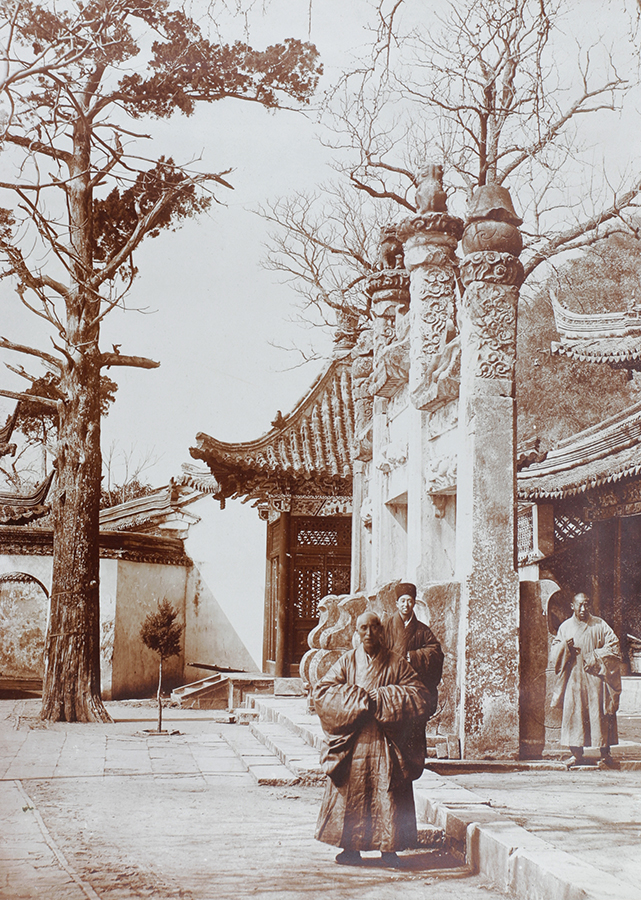
Monks at Silver Island Temple, Ching-Kiang. Edward Wilkinson Collection, Wi01-04, © 2008 Audrey Gregg
Jiaoshan 焦山 in Zhenjiang 鎮江, known as “Silver Island” in English-language sources, was one of three important Buddhist mountain sites in Zhenjiang, the others being Beigu shan 北固山 and Jinshan 金山 or “Golden Island.” While the temples on Jinshan were destroyed several times during the Opium War and the Taiping Civil War, Jiaoshan largely escaped damage. According to one account, the Buddhist monk Liaochan 了禪 and his disciple Wuchun 悟春 steadfastly refused to leave Jiaoshan even when Taiping forces approached. Their bravery so impressed the Taiping military leader that Jiaoshan was spared the destruction of its monasteries. [iii]
Pagoda, Longxing temple, near Chengdu, Sichuan

Pagoda, Longxing temple, near Chengdu, Sichuan. Oliver Hulme Collection, OH02-27, © 2012 Charles Poolton
This temple, located in Pengzhou, Sichuan, dates back to the fourth century. The stone stupa pictured here in ca. 1905-1915 had evidently been badly damaged for some time, but present-day photographs show that it has since been repaired. The contrast between the bustling, blurry crowd of people, who seem to only be barely held back from the photographer’s line of sight, and the ancient stone structure make this image quite striking.
Group on Temple Steps
This photograph, perhaps taken around 1910, is an especially evocative depiction of one important aspect of the relationship between Western visitors and Chinese sacred spaces during this period. A group of five men, who were likely members of the Shanghai Municipal Police force based on the collection of which is image is a part, sit or lie supine on the stone steps of a temple building. A Buddhist religious image has been brought out onto the edge of the top step, and the Stetson-style hat belonging to one of the men has been placed on its head. Most of the men are smiling, and a camera and a bag can be seen.
On the face of it, this image depicts an extremely irreverent act on the part of visitors to the temple, one that the men clearly believe has made for an amusing souvenir photograph. It reflects the widespread lack of respect for local customs that caused a great deal of social friction during the Western presence in China. We do not, however, know what role the temple caretakers played in staging this photograph. Perhaps they agreed to help the tourists to set up this image in exchange for a donation, or were happy to help the odd request of visitors in order to be hospitable. Foreign groups regularly arranged with temples to hold events such as picnics or retreats there, and foreign visitors were welcomed at many temples under the same terms as lay Chinese visitors. [iv]
I do not wish to downplay the serious lack of respect for local religion evidenced in this photograph; indeed this image would be an excellent example to use in a classroom discussion about issues of power, representation, and intercultural (mis)understandings in modern China. Another photograph (HR01-069) from the early 1910s, “Idols inside temple, Canton”, depicts two ‘idols’ in a temple in Guangzhou, and the temple wall behind them is covered with Latin-character graffiti. Yet we will likely never know the whole story behind the creation of this image, and it is important to remember that Westerners were often welcomed as visitors to Chinese sacred spaces, and normally conducted themselves somewhat better than is depicted here.
[i] Gregory Adam Scott, “The Dharma Through a Glass Darkly: On the Study of Modern Chinese Buddhism through Protestant Missionary Sources 彷彿對著鏡子觀看的佛法:藉由基督教傳教士的史料研究現代中國佛教,” Shengyan yanjiu 聖嚴研究 (Sheng Yen Studies), Vol. 2 (July, 2011): 47-73.
[ii] See the 2014 Pew Research Center on religious diversity around the world: http://www.pewforum.org/2014/04/04/global-religious-diversity/
[iii] Jiang Weiqiao 蔣維喬, Zhongguo Fojiao shi 中國佛教史 (Shanghai: The Commercial Press, 1933), fasc. 4, p. 38a.
[iv] See for example the account of a visit to Tiantong Temple in the 1840s or 1850s in W. Tyrone Power, Recollections of a Three Years’ Residence in China (London: R. Bentley, 1853), chapter 25.

